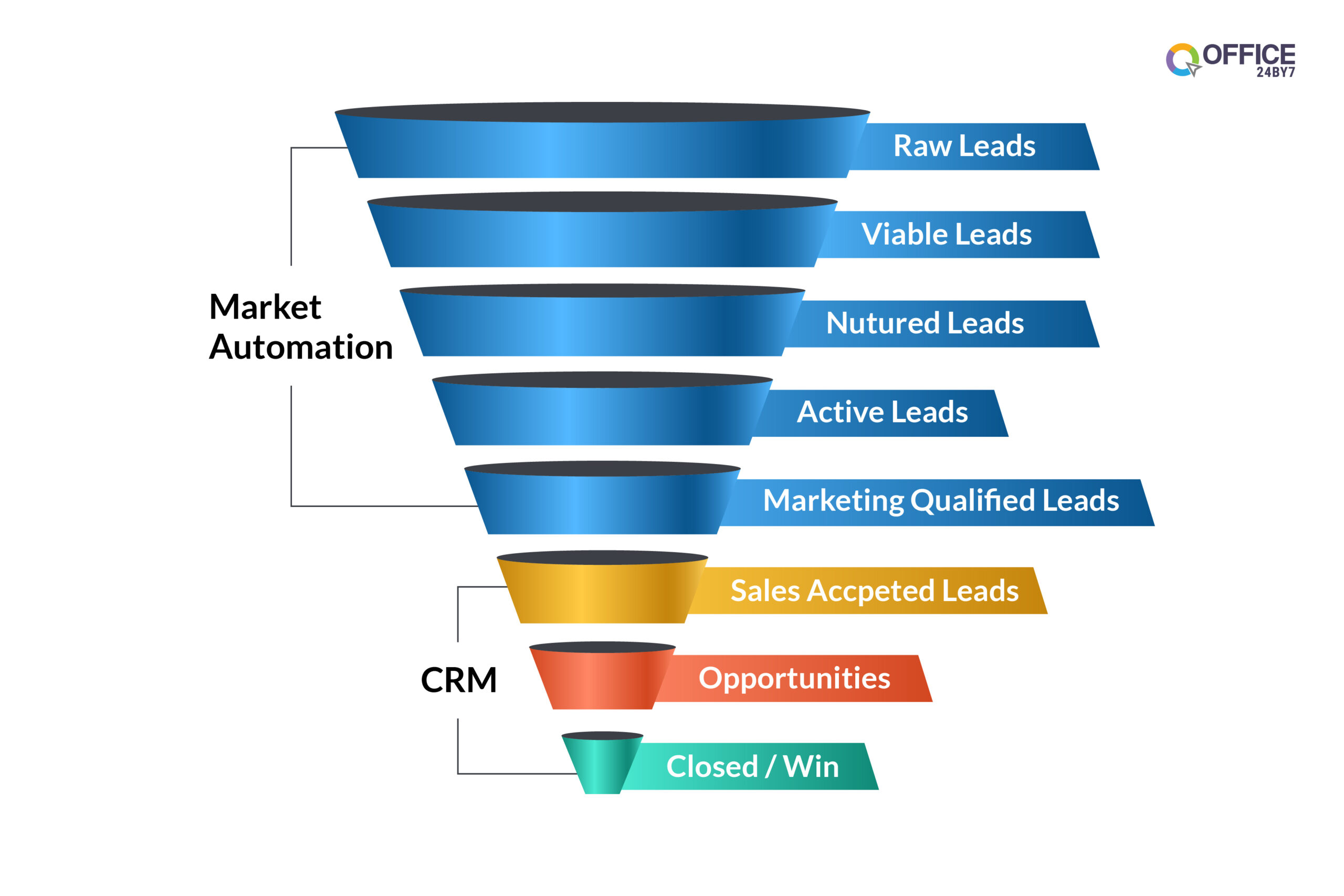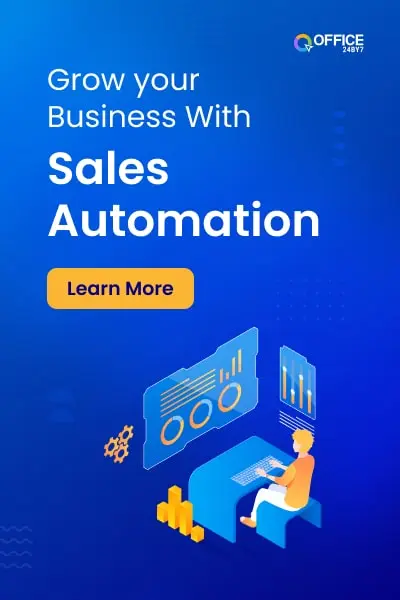
Not sure if this blog on CRM and Marketing automation software contains quality information?
Try our 1-minute short audio summary to decide. 🎧
There is a huge confusion as to why businesses should use CRM software and marketing automation software at the same time. Even though both deal with leads, the purpose of both these software and the types of lead actions that enable you to do so are very different. This means if you only have one of these, your productivity will be reduced to half. Meanwhile having them both integrated would enable you to have a centralized and unified data structure.
In this article, you’ll learn everything you need to know and why you should get them both. We will also go through some easy steps to help you integrate your CRM software with a marketing automation tool.
CRM Software vs. Marketing Automation
The word automation means that it helps you from doing repetitive and less productive tasks. Marketing automation is a derivative of this in marketing activities. On the other hand, CRM software manages customer data and ensures that your customer relationships are stronger.
The differences between CRM and Marketing automation software become more evident when we consider the life stages of a customer.
You attract strangers or generate leads for your business using a Marketing automation tool. Later as they become potential customers you coordinate and control their communications and sales using CRM software. During this stage and later stages, you would also be using the help of marketing automation tools to keep them in the loop, delivering important and relevant promotional material so that they stay interested and feel great about becoming and staying as a customer.

Here are seven key differences between CRM software and marketing automation software:
| CRM Software | Marketing Automation Software |
| Manage customer interactions to get more deals. | Automate marketing campaigns, tasks, and actions. |
| Used by Sales teams. | Used by Marketing teams. |
| Helps you build customer relationships, enhance customer loyalty, and satisfaction. | Helps you to increase engagement, qualify more leads, and streamline marketing efforts. |
| CRM automation helps you sort leads, score leads, and track deals. | Marketing automation helps you schedule posts and send email, SMS, and automated call campaigns. |
| Key features include sales pipeline, lead contact, and lead tracking. | Key features include lead nurturing and marketing communication automation. |
| Reports and analytics provide sales rep performance and the status of the sales pipeline. | Reports measure the performance and effectiveness of marketing campaigns and conversion rates. |
Even though the two software are created for very different purposes, it is important one should co-exist with the other.
Why Should You Integrate Your CRM With Marketing Automation?
Here are five more benefits of marketing automation and CRM software integrations.
1. Unified Customer Data
An all-in-one CRM and marketing automation solution allows businesses to store all customer information in one place. Centralizing sales and marketing data helps identify patterns and trends, such as noticing that customers who engage with email newsletters often make repeat purchases within three months.
With this insight, businesses can create strategies to reward loyal customers, offering points, discounts, or exclusive content to encourage more frequent purchases. Prioritizing customer experience in this way can boost referral rates, customer acquisition, and repeat business, giving companies a competitive edge.
The more enjoyable and seamless the customer experience, the greater the likelihood of customers returning for future purchases. By enhancing engagement, businesses can develop long-term loyalty and drive continued sales growth.
2. Healthy Sales Funnel
A CRM and marketing automation system allows you to assess lead potential using criteria like location, income, or shopping habits. By personalizing interactions over time, you can nurture leads more effectively. CRM features help automatically qualify leads based on demographics or behavior, and then assign a lead score to prioritize them accordingly.
Once leads are scored, marketing automation can trigger follow-up campaigns to guide your most qualified prospects toward the next step in their journey. Automating lead qualification ensures that sales teams focus only on high-quality leads, while marketing automation keeps prospects engaged until they are ready to make a purchase.
3. Consistent Data Across All Departments
By keeping both CRM and marketing automation platforms updated within one system, you ensure consistent data across all departments. This unified data allows for more accurate reporting and informed decision-making, enhancing the overall efficiency of your business processes.
A streamlined approach eliminates data silos, enabling you to track and analyze interactions across multiple touchpoints with confidence. This clarity provides a complete view of customer journeys, ensuring that your strategies are based on reliable, comprehensive insights.
Which Automation Tools and Technology Do You Use?
92% of respondents utilize at least one automation tool in their daily operations. This indicates that many of your competitors may already be leveraging integrated systems. To stay competitive, it’s essential to have a unified view of customer interactions and campaign performance.
Office24by7 offers best-in-class office automation solutions designed to meet all your business needs. Their sales, communication, marketing, and support automation tools work seamlessly together to create a robust framework for your operations. Experience the benefits firsthand by signing up for a free trial of the Office24by7 Marketing Automation tool today!
4. Personalized Marketing Efforts
Real-time CRM insights offer a clearer understanding of each customer, allowing you to craft more targeted sales and marketing messages. For instance, if a customer frequently engages with content about your new accounting software, you can trigger a personalized email with a discount to encourage an upgrade.
Tailoring campaigns like this can significantly boost sales. Research shows that over half of consumers become repeat buyers after a personalized experience, with this preference growing by 7% annually. While marketing automation powers these campaigns, CRM systems help manage the resulting customer relationships and communication strategies.
5. Aligned Sales and Marketing
Using a single, integrated system to share and track both sales and marketing efforts ensures that both teams have a clear overview of what’s working and what isn’t. This visibility helps team members understand each other’s roles better and fosters collaboration for more effective strategies.
When sales and marketing teams work together, they can create consistent messaging that offers a seamless experience for prospects transitioning from leads to customers. For instance, marketers can develop content based on sales reps’ notes on common customer pain points, and sales teams can leverage this content in their interactions.
This coordinated approach provides prospects with relevant, consistent information throughout their journey. Over time, it builds trust, increases engagement, and boosts the chances of repeat business.

Related Reading
Best Practices to Integrate CRM Software With Marketing Automation
It is a challenging task to integrate a CRM with a Marketing automation tool if you do not have a well-thought-out process. Don’t worry! Here are some step-by-step instructions as to how you can effectively integrate these systems for enhanced productivity with minimum hassle.
1. Choosing the Correct Software
No one software fits all businesses. So instead of going with the most costly or the most self-proclaimed best software out there, you need to prioritize your requirements and constraints. Make a list of your specific feature requirements and also your constraints like your budget, industry, size of the company, etc.
For example, if you are a small SaaS startup you would need to prioritize different things than a large logistics company. These would make your choices also differ. If you’re new to the market and are searching for a customizable CRM platform with marketing automation capabilities, that provides excellent customer support and all these for an affordable price, you are definitely going to end up with the name Office24by7.
Office24by7 is an all-in-one CRM software with marketing automation capabilities. Some of the top crucial features it provides include:
- Lead tracking
- Pipeline management
- Extensive reporting and analytics
- Best-in-class automation capabilities
- Mobile and web platforms
- Third-party integrations
- Custom dashboard and filters
- Omnichannel communication capabilities
- A great customer support team for all your concerns despite of whichever subscription you choose.
2. Data Cleansing
Before implementing a CRM integration, it’s crucial to clean and merge any duplicate entries in your data. Cleansing ensures that sales and marketing activities are more accurate and efficient, preventing potential confusion. A clean dataset allows for smoother communication between teams and more reliable outreach to your customers.
Duplicate entries, like having two profiles for the same customer, can lead to redundant communications. This not only reduces engagement but may also damage your credibility. Streamlining data through automated systems, such as Office24by7 offers automatic deduplication functionality that helps you can merge or separate profiles, ensuring clarity in your customer database.
A clean contact list enhances the precision of marketing efforts and prevents unnecessary outreach. With tools like Office24by7, duplicates are identified and resolved automatically, saving time and improving accuracy. Keeping your data organized allows for better insights, helping your business make informed decisions and build trust with your customers.
Minimize your work efforts with automations!

3. Continuous Training
Before and after implementing CRM and marketing automation, it’s essential to hold joint meetings with sales and marketing teams. This ensures everyone understands the reasons behind the change and has a chance to share feedback. By providing early communication, you can secure commitment and ensure consistent usage of the new tools across teams.
Open communication is vital for buy-in. For example, marketing might benefit from knowing that the new software sends targeted content based on customer interactions, such as an email follow-up after the customer downloads an e-book. Sales teams can provide input on further segmenting leads based on behaviors indicating readiness to purchase.
Once the software is live, regular training sessions should be kept. These sessions can cover new feature walkthroughs, best practices for data entry, and role-specific tips for maximizing efficiency. Ongoing training, combined with feedback loops, ensures that team members can troubleshoot issues and continuously improve collaboration.
4. Monitoring Performance
Key performance indicators (KPIs) provide measurable goals for evaluating software performance. Selecting the right metrics and using tools like Office24by7 to track them ensures you can assess how effectively your integration is turning leads into customers. Monitoring KPIs such as lead conversion rates and sales cycle lengths helps identify areas needing improvement.
Automating data analysis with Office24by7 enables quick identification of trends and patterns. This visualization simplifies decision-making processes, allowing you to adjust strategies promptly based on real-time insights. For instance, automated reports can highlight whether your integration efforts are accelerating lead conversions or if bottlenecks are slowing down the process.
Establishing clear benchmarks at the outset guides your evaluation process. These initial metrics provide a baseline for measuring performance improvements over time. By consistently monitoring KPIs, such as customer acquisition costs or return on investment (ROI), you can gauge the overall effectiveness of your software integration and refine strategies accordingly.
Here are some of the KPIs you could track:
- Lead Conversion Rate: The percentage of leads that turn into paying customers.
- Customer Acquisition Cost (CAC): Sales and marketing expenses it takes till a customer starts to pay.
- Length of Sales Cycle: The average time taken to convert a lead into a paying customer.
- Lead Response Time: Rate at which the leads starts to show interest in the product.
- Customer Retention Rate (CRR): The percentage of customers who continue to do business with you over a given period.
- Pipeline velocity: The speed at which leads move through your sales pipeline.
- Average Deal Size: The average value of closed deals.

Related Reading
Feel the power of a CRM Software!






